Abstract
Convolutional neural networks (CNNs) have become a primary approach in the field of artificial intelligence (AI), with wide range of applications. The two computational phases for every neural network are; the training phase and the testing phase. Usually, testing is performed on high-processing hardware engines, however, the training part is still a challenge for low-power devices. There are several neural accelerators; such as graphics processing units and field-programmable-gate-arrays (FPGAs). From the design perspective, an efficient hardware engine at the register-transfer level and efficient CNN modeling at the TensorFlow level are mandatory for any type of application. Hence, we propose a comprehensive, and step-by-step design procedure for a re-configurable CNN engine. We used TensorFlow and Keras libraries for modeling in Python, whereas the register-transfer-level part was performed using Verilog. The proposed idea was synthesized, placed, and routed for 180 nm complementary metal-oxide semiconductor technology using synopsis design compiler tools. The proposed design layout occupies an area of 3.16 × 3.16 mm2. A competitive accuracy of approximately 96% was achieved for the Modified National Institute of Standards and Technology (MNIST) and Canadian Institute for Advanced Research (CIFAR-10) datasets.
1. Introduction
The past decade has witnessed exponential growth in the field of artificial intelligence (AI) owing to its promising real-time results made possible through convolutional neural networks (CNNs). CNNs have performed exceptionally well in the field of computer vision, such as in image classification, object recognition and natural language processing [1,2,3,4]. AI though the CNN technique is years old but it cannot gain attention due to its high computational power requirements and the large number of complex operations involved. Typically, a CNN is implemented using a graphical processing unit (GPU) because of advancements in computational capabilities and the development of implementing tools (e.g., TensorFlow, Matlab). These tools allow users to customize the CNN model according to application requirements and deployment of multi-devices, central processing units (CPUs) and GPUs.
Although a GPU outperforms a CPU in terms of throughput, it drains a large amount of energy, and makes it infeasible for energy-limited resources, such as mobile devices, embedded systems, and IoT. Contrarily, CNN implementation on field-programmable-gate-arrays (FPGA) has shown superior results in terms of output and power efficiency, mainly because of parallel and configurable approaches [5,6,7].
Different approaches have different advantages and disadvantages, and FPGA is no exception. Although the FPGA has numerous advantages, it is difficult to implement in hardware description languages (HDL). A thorough understanding of CNN architectures, functionality parameters, and detailed knowledge of register-transfer level (RTL) design techniques on FPGA is required for both fixed and floating point designs. The efficient design of a CNN engine requires many considerations, including off-board memory access latency, on-chip memory re-usability, and high-performance arithmetic circuits [8]. Because the computational complexity of CNN increases with the availability of reliable data, there is a need for a re-configurable neural engine design.
There have been several attempts to reduce the gap between FPGA and CNN; however, the majority of these have focused on efficient algorithm design and performance optimization. Some effective optimization techniques for CNN implementation on FPGA have been proposed for creating re-configurable CNN engines. As per [9], a typical CNN architecture is 90% of its computing convolutional layers; hence, handling convolutional operations is a major concern. In the literature, there are several proposals for the optimization of CNN data paths for FPGA-based designs; a detailed survey is provided in [10]. An in-depth analysis of loop unrolling, and the loop tiling method was performed by Yufei Ma et al., in [11]. In the proposed method the throughput of the convolutional layer’s is improved but at the cost of more hardware. Ma et al. [12] presented an adder tree and configurable multiplier bank based RTL compiler for various CNN architectures. The same authors proposed an improved technique in [13] based on their earlier work in [11], using a loop optimization technique. However, it can be deduced that their focus has been on compiler throughput optimization in some state-of-the-art CNN models and is limited to RTL generation by overlooking the comprehensive step from CNN modeling to training and synthesis.
Various libraries and framework-based approaches have been proposed by several researchers. Wang et al. [14] presented a scalable deep-learning engine with configurable tiling sizes; however, their accelerator was designed to infer only feed-forward neural networks. In [15], a library named Caffe was presented that automatically generates a high-level synthesis (HLS)-based CNN engine with marginal low-level hardware optimization. A pre-trained script description-based RTL-CNN generator was presented in [16]. In [17], an HLS-based framework called fpgaConvNet was proposed. Similarly, a framework called FP-DNN was proposed in [18], which automatically generates a hybrid RTL-HLS CNN engine.
However, there are software libraries that facilitate research on AI and DL (TensorFlow, Keras, and PyTorch). Thanks to researchers and developers, they uploaded the datasets MNIST [19], and CIFAR-10 [20], which can be used with high-level programming languages such as Python. The performance and energy requirements for deep learning are major constraints, particularly in embedded systems. Hence, instead of using GPU-based energy expensive solutions, it is important to design a power and energy-efficient re-synthesizable hardware engine.
Building high-performance custom hardware is challenging in terms of the design process [21,22,23]. The hardware architecture for such complex algorithms using low-level HDL requires considerable time and effort. By reviewing the related literature, time and effort can be seen in [24]. While some studies have focused on generating built-in coefficients [25], others include training phase in hardware [26,27]. In [28], an accelerator was designed a using Vivado HLS to speed up the analysis phase in memory which was implemented on zynq-7000 FPGA.
This study presents comprehensive steps for designing an FPGA-based reconfigurable CNN engine using the latest libraries and tools in an optimized manner. The main contributions are as follows:
- A compact and accurate TensorFlow-based CNN model was developed using Python which can simulate a variety of datasets.
- Implemented a step-by-step reconfigurable CNN engine on FPGA from scratch.
- The RTL design of the CNN model was synthesized using 180 nm CMOS technology and post-layout verification was carried out. The results of the FPGA and 180 nm testing were compared with the software model for validation.
- A graphical user interface (GUI) is designed for the loading and testing of data sets.
The rest of the paper is organized as follows: Section 2 presents the design flow of the proposed study. The details of the TensorFlow/MATLAB implementation are given in Section 3. The RTL implementation and sub-blocks are presented in Section 4. The synthesis, place and route, layout and simulation results are presented in Section 5. Finally, the conclusions are presented in Section 6.
2. Proposed Design Flow
The complete design process consists of two main phases and several sub-phases as shown in Figure 1. The two main phases are the CNN architecture modeling and training in TensorFlow and the hardware implementation system based on the register-transfer level (RTL) compiler. In TensorFlow, the following two major operations are performed: (1) CNN architecture is modeled, trained, tested, and trained weights and bias data are saved in a .txt file; (2) input feature map data is converted into binary data, which can be recognized by hardware tools and saved as a .txt file for further processing.
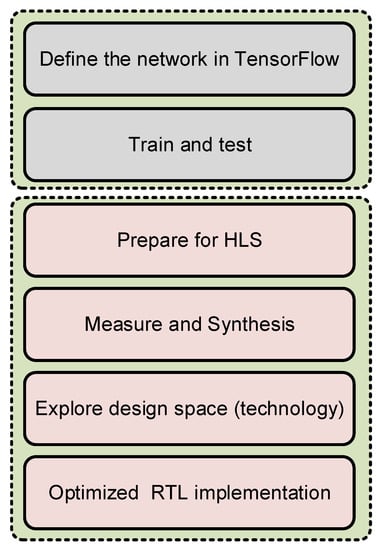
Figure 1.
Top structure of CNN hardware implementation.
Once the modeling was completed in TensorFlow, the RTL design is implemented in Verilog/VHDL. The synthesis follows the place and route (PnR) process, where the proposed design is comprehensively checked, optimized as per the target application, and finally implemented. Figure 2 shows the major steps involved in the design process from scratch to the final implementable design. For testing purposes, a customized graphical user interface (GUI) is developed for loading datasets, trained model weight files, and output display.
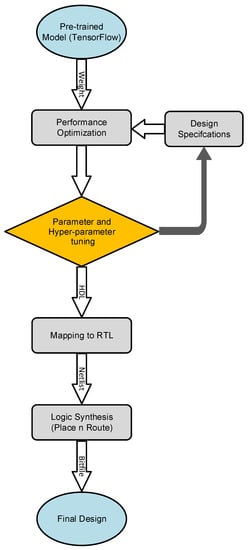
Figure 2.
Flow chart of proposed CNN engine design.
A detailed design flow chart of the CNN engine generator is shown in Figure 2. As mentioned earlier, the CNN model is initially trained using TensorFlow. Weight and Bias value files are imported and these are further tuned as per the application requirements. Once the requirements of the specification are achieved, RTL design is implemented in Verilog/VHDL. There is no need of implementing everything from scratch, as an initially highly optimized model is implemented and tested. For re-usability, necessary changes need to be done depending on the requirements of the application. After RTL mapping, a netlist file is imported for synthesis following the place and route (PnR) process, where the proposed design is comprehensively checked, and optimized as per the target application and a final design is ready for deployment, either on FPGA or ASIC. The final design is tested with the help of a customized GUI developed for loading datasets, trained model weight files and output display.
3. CNN Overall Operation
The core of any hardware implementation starts with software modeling. In deep learning the selection of the correct CNN architecture, dataset and parameters are crucial The design complexity, computational power, accuracy, and ASIC implementation area depend on the chosen CNN model.
The detailed procedure is shown in Figure 3. The implementation of the CNN model starts with the selection of built-in frameworks. Different frameworks provide different data handling, mathematical, and graphical libraries, which are publicly available under different licenses. For example, NumPy is the best for dataset handling, whereas Matplotlib deals with plotting verities of graphs. For deep learning, there are three main frameworks: Keras, PyTorch and PyCharm. This study was conducted on Keras and TensorFlow at the backend. Once the right frame is selected, the dataset is prepared. Dozens of well-prepared open-source datasets are available, which are good for testing purposes. Classified data, must be prepared for the CNN. Data are not always well managed, and the accuracy of any CNN model is highly dependent on the dataset. It is also important to have a sufficient number of samples. A dataset that is too small, may result in over-fitting or under-fitting of the model. Generally, a data set is split into two parts in a ratio of 80/20, where 80% of the data are used for training and 20% are saved for testing and validation.
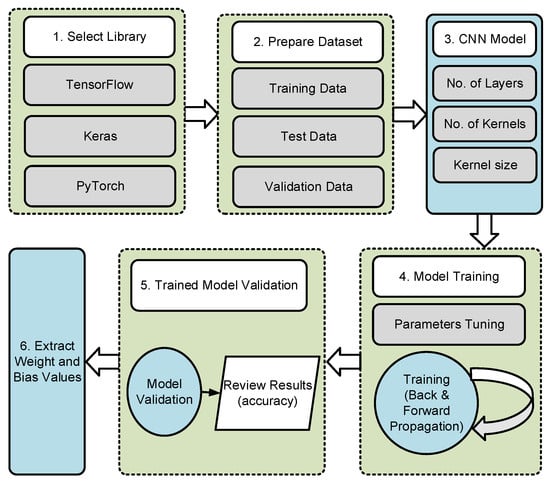
Figure 3.
Implementation flow of the proposed CNN engine.
Once the data are ready, the next step is model training which is the most crucial step. Training is an iterative process, which involves complex mathematical computations. Training has two major operations: forward propagation and backpropagation. In forward propagation, starting from the input data, the weight and bias values are convolved and forward propagated to the next operational layer, adding weight and bias values untill the final SoftMax layer. Forward propagation involves several layer-wise operations; that is, convolutional, pooling (max or average), activation, and dense layers. Each layer-wise operation is discussed in detail in the following section. Forward propagation is followed by backpropagation.
Back-propagation computes the gradient of the loss function with respect to weight using the chain rule. In supervised learning, the output vector is generated from input vectors, and an error/loss is generated if the desired output is not achieved. The parameters (weights/bias) values are adjusted to achieve the best output results. Computing the gradient layer-by-layer, and iterating backward from the last layer to avoid redundant computation of intermediate terms in the chain rule.
Each stage is explained in detail, in the following steps.
3.1. Uploading the Dataset
The MNIST/CIFAR10 and other open datasets are available for learning. In this study, we used the MNIST dataset. Once the dataset is successfully loaded, 4 random samples are printed for confirmation purposes shown in Figure 4.
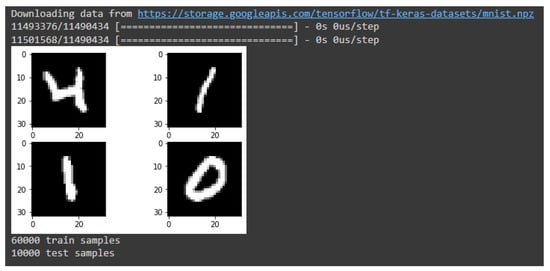
Figure 4.
Dataset download and printing of random samples.
3.2. Divide the Dataset into Test/Training Dataset
Once the dataset is loaded/downloaded, it must be split into two sets: the training and test datasets. Usually, the 80/20 ratio is used. Figure 5 shows the divided datasets.
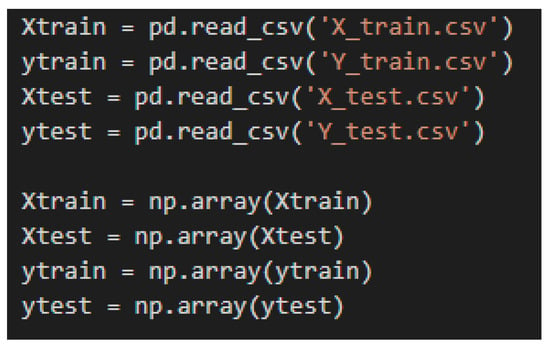
Figure 5.
Dividing the dataset into Training and Test datasets.
3.3. Define the CNN Architecture
The definition of the CNN architecture contains comprehensive details of the parameters and hyper-parameters. Information on the number of convolutional layers, fully connected layers, number of kernels, kernel size, pooling type, pooling size, stride window, activation function, number of epochs, batch size, learning rate, and use of bias information is provided. The selection of parameters is shown in Figure 6.
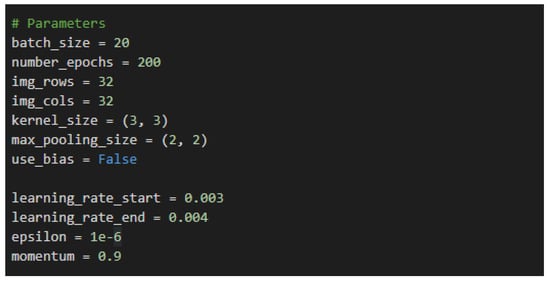
Figure 6.
Definition of parameters.
3.4. Output Accuracy Optimization
Once the CNN architecture is selected, it is compiled before the training starts. In this step, we define the loss function, optimizer and metrics. After the fit function measures, the performance of CNN model is determined. Fitting refers to adjusting the parameters in the model to improve accuracy, as shown in Figure 7.

Figure 7.
Selection of optimizer and loss function for output accuracy tuning.
3.5. Saving the Trained Model and Weight Values
The model can be saved after and during the training. This means that we can resume if it is left incomplete for any reason. A replica of the model can be created using the saved model and weight file. In this study, we loaded the saved weight values for hardware processing. The saving commands are shown in Figure 8.

Figure 8.
Commands for saving trained model and weight files.
4. CNN: Layerwise Implementation
4.1. Proposed Top CNN Engine
Our aim is to present a power-efficient design implementation technique that does not compromise the CNN structure and accuracy. The CNN engine is the most frequently used system for all applications, and thus consumes more power. The top CNN engine is shown in Figure 9, where the power consumption is reduced by reusing the memory, which occupies a major portion of the CNN engine. We applied the memory re-use technique, in which the input feature buffer memory was re-used for storing the updated weights values after each iteration.
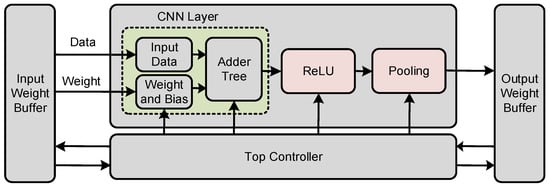
Figure 9.
Top architecture of the proposed CNN engine.
4.2. Convolutional Layer
The convolutional layer is used to identify the primary features in the image by convolving with a set of learnable filters. Convolution is a linear and simple multiplication operation of a single or multi-dimensional array vector called filters with an input array. The filter’s dimensions are significantly small (3 × 3, 5 × 5, or 7 × 7) as compared to the input data dimension. Each filter is convolved horizontally and vertically in a sliding window fashion with input data resulting in an array of feature maps. The number of features maps is equal to the number of convolved filters. The detailed CNN architecture is shown in Figure 10. The element-wise multiplication and summation operations are given in Equation (1).

Figure 10.
Detailed CNN architecture.
During the mathematical operation, a bias term was added to the sum of the weighted input. The following equation shows the calculation of the output feature map.
where padding is the optional number of pixel values added to maintain the optimal dimension. When an image is convolved with filters, and the stride slides the filters with a certain number of pixels across the input array, sliding windows are fixed according to the output results.
4.3. Pooling Layer and Activation Function
The pooling layer works similar to the convolutional layer. This diminishes the spatial size of convolved features. Moreover, it aids in dimension reduction during dominant feature extraction to achieve the highest recognition accuracy. Pooling operation can be performed in two ways: average pooling and maximum pooling. Maximum pooling. Maximum pooling takes the dominant pixel value from the chosen pooling windows, whereas, average pooling takes the average of the selected pooling window. Both methods ultimately result in a dimension reduction.
After calculation the weighted sum and bias values, the activation function determines whether to fire a neuron, which is the same as checking the threshold. The primary aim of the activation function is to add non-linearity to the output. A neural network without an activation function is similar to linear regression problem, which does not support complex mathematical operations. In summary, an activation function improves the neural network by learning and performing complex functions. The most widely used activation functions are sigmoid, ReLU, and Tanh [29]. These functions optimize the detection rate of CNN, however, they are rarely used in real world applications, to be exact on hardware, as memory is limited.
4.4. Fully Connected Layer
The final output from the convolution and pooling operations is followed a by flattened layer. The fully connected (FC) layer works like a layer of the multi-layer perceptron and consists of more than one FC layer. The final output of the entire convolutional operation is saved in a single-column vector. Each value in the column indicates the probability that the features match the label. The FC layer is used to convert the images into labels based on the learned features from the convolutional process. Each neuron carries certain probability value. The neuron with the highest probability value is declared the output, and the corresponding label classifies that particular class.
5. Synthesis and Results
The design compiler tool is the core of Synopsys synthesis products. It optimizes the design for the area and power-efficient local representation of given blocks. The design compiler consists of hardware description language (HDL) design synthesis tools that optimize gate-level designs. Both combinational and sequential designs can be optimized for speed, power, and area.
Figure 5 shows the steps to be followed for the synthesis with the design compiler. These steps include reading the VHDL/Verilog source file in the design, applying the constraints as per the specification, and design optimization. The reading of HDL design involved two tasks. First, the command analysis checks the syntactical errors, creates libraries, and saves the HDL intermediate files at a specified location. The second task is command elaboration, which translates intermediate files into a technology-independent design produced during the analysis. In the elaboration report, we can see the number and types of memory elements. If the elaboration is completed successfully, the next step is the constraints defining. Constraints are the set of parameters that the designer provides to a design compiler in order to limit the operations the synthesis tool can or cannot perform with the design and its behavior.
Figure 11 shows the synthesized layout of the proposed CNN engine, following the steps presented in this manuscript. It was synthesized for a 180 nm CMOS process using a design compiler and IC compiler. It occupies a 3.16 mm × 3.16 mm die area. To verify the proposed design procedure, we tested our design using open-source datasets MNIST, CIFAR-10, and STL-10, as shown in Table 1. A comparison with other state-of-art proposed designs is presented in Table 2. Most of the proposed ideas are limited to FPGAs. The proposed procedure covers both software and hardware implementations, and synthesis up to the ASIC level.

Figure 11.
Layout of the proposed CNN engine.

Table 1.
Tested Dataset.

Table 2.
Performance comparison with related works.
A customized controller-based GUI was developed for testing, as shown in Figure 12. It was used to load the pre-trained weight and bias values files, and input data for testing. This GUI has many other control options, such as enable, reset, read, and write. Using this GUI, we can verify the output after each convolutional layer. To read and write, the files must be saved within a particular system path, where they can load to read or save to write. It reads the test simple pixel value in vector form, and weights values in hexadecimal. The final output class field is marked as the ANIC Class, which shows the final output class after the test. The tensor flow modeling results are shown in Figure 13a, in which we achieved the precision score of approximately 96. The proposed CNN engine design procedure was verified at the RTL level as shown in Figure 13b,c. It correctly classified the data as classified in the GUI.
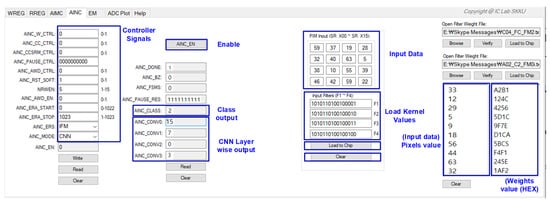
Figure 12.
A customized GUI for testing.
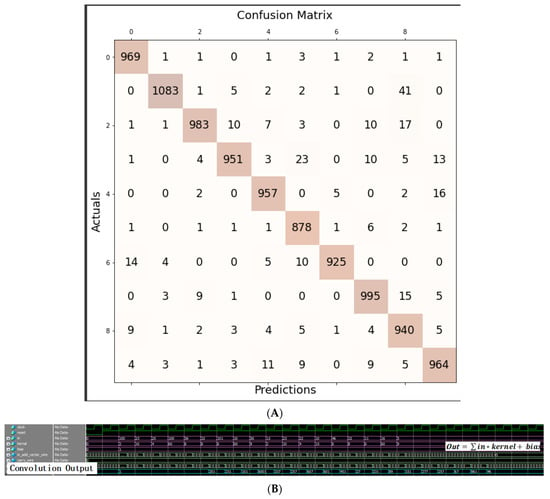
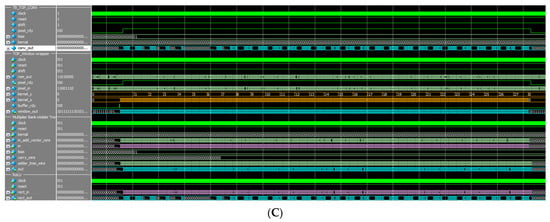
Figure 13.
(A) Tensor flow result of Proposed CNN. (B) Result of Convolutional Layer. (C) Result of the proposed CNN engine with controller.
6. Conclusions
In this study, an SW/HW co-design procedure is presented for designing a CNN engine to fill the gap owing to its fast growth and lower power re-configurable FPGA-based applications. This was achieved by proposing a detailed design procedure for a customizable and re-configurable CNN engine.
Additionally, any user can generate as many FPGA-based CNN models as possible without starting every time from the very scratch, through slight modifications as per the application requirements and following the detailed steps. With a given framework, a user can integrate new layers for modern CNN models and add features to the existing layers. All RTL blocks are hand-coded in Verilog; thus FPGA (Altera, Xilinx) implementation and verification are handy. All CNN models can be easily processed for the ASIC implementations. The design process used TensorFlow and MATLAB to train and test the CNN model before implementation. The proposed design idea was validated on different data sets (MNIST and, CIFAR-10) and competitive results were achieved. A customized GUI makes it easier to perform testing with simple clicks. Furthermore, the proposed design procedure achieved considerable accuracy.
Author Contributions
Conceptualization, P.K.; methodology, P.K. and I.A.; software, P.K. and I.A.; validation, investigation P.K. and I.A.; resources D.-G.K. (Dong-Gyu Kim); data curation, S.-J.B. and D.-G.K. (Dong-Gyun Kim); writing—draft presentation, P.K.; writing—review and editing, P.K. and K.-Y.L.; supervision, K.-Y.L., I.A. and Y.-G.P.; project administration, K.-Y.L.; funding acquisition, K.-Y.L. All authors have read and agreed to the published version of the manuscript.
Funding
This work was supported by Institute of Information & communications Technology Planning & Evaluation (IITP) grant funded by the Republic of Korea government(MSIT) (No. 2019-0-00421, Artificial Intelligence Graduate School Program(Sungkyunkwan University)) and was supported by the MSIT (Ministry of Science and ICT), Republic of Korea, under the ICT Creative Consilience Program (IITP-2022-2020-0-01821) supervised by the IITP (Institute for Information & communications Technology Planning & Evaluation).
Conflicts of Interest
The authors declare no conflict of interest.
References
- Lecun, Y.; Bottou, L.; Bengio, Y.; Haffner, P. Gradient-based learning applied to document recognition. Proc. IEEE 1998, 86, 2278–2324. [Google Scholar] [CrossRef]
- Verma, N.K.; Sharma, T.; Rajurkar, S.D.; Salour, A. Object identification for inventory management using convolutional neural network. In Proceedings of the 2016 IEEE Applied Imagery Pattern Recognition Workshop (AIPR), Washington, DC, USA, 18–20 October 2020; pp. 1–6. [Google Scholar]
- LeCun, Y.; Boser, B.; Denker, J.S.; Henderson, D.; Howard, R.E.; Hubbard, W.; Jackel, L.D. Backpropagation Applied to Handwritten Zip Code Recognition. Neural Comput. 1989, 1, 541–551. [Google Scholar] [CrossRef]
- Yadav, S.S.; Jadhav, S.M. Deep convolutional neural network based medical image classification for disease diagnosis. J. Big Data 2019, 6, 113. [Google Scholar] [CrossRef]
- Asano, S.; Maruyama, T.; Yamaguchi, Y. Performance comparison of FPGA, GPU and CPU in image processing. In Proceedings of the 2009 International Conference on Field Programmable Logic and Applications, Prague, Czech Republic, 31 August–2 September 2009; pp. 126–131. [Google Scholar]
- Mousouliotis, P.G.; Petrou, L.P. CNN-Grinder: From Algorithmic to High-Level Synthesis descriptions of CNNs for Low-end-low-cost FPGA SoCs. Microprocess. Microsyst. 2020, 73, 102990. [Google Scholar] [CrossRef]
- Lacey, G.; Taylor, G.W.; Areibi, S. Deep learning on FPGAs: Past, present, and future. arXiv 2006, arXiv:1602.04283. [Google Scholar]
- Shawahna, A.; Sait, S.M.; El-Maleh, A. FPGA-based accelerators of deep learning networks for learning and classification: A review. IEEE Access 2019, 7, 7823–7859. [Google Scholar] [CrossRef]
- Cong, J.; Xiao, B. Minimizing computation in convolutional neural networks. In Artificial Neural Networks and Machine Learning–ICANN 2014, Proceedings of the 24th International Conference on Artificial Neural Networks (ICANN 2014), Hamburg, Germany, 15–19 September 2014; Springer International Publishing: Cham, Switzerland, 2014; pp. 281–290. [Google Scholar]
- Abdelouahab, K.; Pelcat, M.; Serot, J.; Berry, F. Accelerating CNN inference on FPGAs: A survey. arXiv 2018, arXiv:1806.01683. [Google Scholar]
- Ma, Y.; Cao, Y.; Vrudhula, S.; Seo, J.S. Optimizing loop operation and dataflow in FPGA acceleration of deep convolutional neural networks. In FPGA ‘17: Proceedings of the 2017 ACM/SIGDA International Symposium on Field-Programmable Gate Arrays, Proceedings of the 2017 ACM/SIGDA International Symposium on Field-Programmable Gate Arrays, Monterey, CA, USA, 22–24 February 2017; Association for Computing Machinery: New York, NY, USA, 2017; pp. 45–54. [Google Scholar]
- Ma, Y.; Suda, N.; Cao, Y.; Seo, J.S.; Vrudhula, S. Scalable and modularized RTL compilation of convolutional neural networks onto FPGA. In Proceedings of the 2016 26th International Conference on Field Programmable Logic and Applications (FPL), Lausanne, Switzerland, 29 August–2 September 2016; pp. 1–8. [Google Scholar]
- Ma, Y.; Cao, Y.; Vrudhula, S.; Seo, J.S. An automatic RTL compiler for high-throughput FPGA implementation of diverse deep convolutional neural networks. In Proceedings of the 2017 27th International Conference on Field Programmable Logic and Applications (FPL), Ghent, Belgium, 4–8 September 2017; pp. 1–8. [Google Scholar]
- Wang, C.; Gong, L.; Yu, Q.; Li, X.; Xie, Y.; Zhou, X. DLAU: A scalable deep learning accelerator unit on FPGA. IEEE Trans. Comput. Aided Des. Integr. Circuits Syst. 2017, 36, 513–517. [Google Scholar] [CrossRef]
- Aghdam, H.H.; Heravi, E.J. Caffe Library. In Guide to Convolutional Neural Networks; Springer International Publishing: Cham, Switzerland, 2017; pp. 131–166. [Google Scholar] [CrossRef]
- Rivera-Acosta, M.; Ortega-Cisneros, S.; Rivera, J. Automatic Tool for Fast Generation of Custom Convolutional Neural Networks Accelerators for FPGA. Electronics 2019, 8, 641. [Google Scholar] [CrossRef]
- Venieris, S.I.; Bouganis, C.-S. fpgaConvNet: A framework for mapping convolutional neural networks on FPGAs. In Proceedings of the 2016 IEEE 24th Annual International Symposium on Field-Programmable Custom Computing Machines (FCCM), Washington, DC, USA, 1–3 May 2016; pp. 40–47. [Google Scholar]
- Guan, Y.; Liang, H.; Xu, N.; Wang, W.; Shi, S.; Chen, X.; Sun, G.; Zhang, W.; Cong, J. FP-DNN: An automated framework for mapping deep neural networks onto FPGAs with RTL-HLS hybrid templates. In Proceedings of the 2017 IEEE 25th Annual International Symposium on Field-Programmable Custom Computing Machines (FCCM), Napa, CA, USA, 30 April–2 May 2017; pp. 152–159. [Google Scholar]
- Deng, L. The MNIST Database of Handwritten Digit Images for Machine Learning Research [Best of the Web]. IEEE Signal Process. Mag. 2012, 29, 141–142. [Google Scholar] [CrossRef]
- Krizhevsky, A.; Hinton, G. Learning Multiple Layers of Features from Tiny Images. 2009. Available online: http://www.cs.utoronto.ca/~kriz/learning-features-2009-TR.pdf (accessed on 15 November 2022).
- Russakovsky, O.; Deng, J.; Su, H.; Krause, J.; Satheesh, S.; Ma, S.; Huang, Z.; Karpathy, A.; Khosla, A.; Bernstein, M.; et al. ImageNet Large Scale Visual Recognition Challenge. Int. J. Comput. Vis. 2015, 115, 211–252. [Google Scholar] [CrossRef]
- Byun, S.-J.; Kim, D.-G.; Park, K.-D.; Choi, Y.-J.; Kumar, P.; Ali, I.; Kim, D.-G.; Yoo, J.-M.; Huh, H.-K.; Jung, Y.-J.; et al. A Low-Power Analog Processor-in-Memory-Based Convolutional Neural Network for Biosensor Applications. Sensors 2022, 22, 4555. [Google Scholar] [CrossRef] [PubMed]
- Kumar, P.; Yingge, H.; Ali, I.; Pu, Y.-G.; Hwang, K.-C.; Yang, Y.; Jung, Y.-J.; Huh, H.-K.; Kim, S.-K.; Yoo, J.-M.; et al. A Configurable and Fully Synthesizable RTL-Based Convolutional Neural Network for Biosensor Applications. Sensors 2022, 22, 2459. [Google Scholar] [CrossRef] [PubMed]
- Moolchandani, D.; Kumar, A.; Sarangi, S.R. Accelerating CNN Inference on ASICs: A Survey. J. Syst. Arch. 2020, 113, 101887. [Google Scholar] [CrossRef]
- Alzubaidi, L.; Zhang, J.; Humaidi, A.J.; Al-Dujaili, A.; Duan, Y.; Al-Shamma, O.; Santamaría, J.; Fadhel, M.A.; Al-Amidie, M.; Farhan, L. Review of deep learning: Concepts, CNN architectures, challenges, applications, future directions. J. Big Data 2021, 8, 53. [Google Scholar] [CrossRef]
- Nazemi, M.; Eshratifar, A.E.; Pedram, M. A hardware-friendly algorithm for scalable training and deployment of dimensionality reduction models on FPGA. In Proceedings of the 2018 19th International Symposium on Quality Electronic Design (ISQED), Santa Clara, CA, USA, 13–14 March 2018; pp. 395–400. [Google Scholar]
- He, X.; Lu, W.; Yan, G.; Zhang, X. Joint Design of Training and Hardware Towards Efficient and Accuracy-Scalable Neural Network Inference. IEEE J. Emerg. Sel. Top. Circuits Syst. 2018, 8, 810–821. [Google Scholar] [CrossRef]
- Li, C.; Bi, Y.; Benezeth, Y.; Ginhac, D.; Yang, F. High-level synthesis for FPGAs: Code optimization strategies for real-time image processing. J. Real Time Image Process. 2017, 14, 701–712. [Google Scholar] [CrossRef]
- Layer Activation Functions. Keras Website. Available online: https://keras.io/api/layers/activations/ (accessed on 15 November 2022).
Publisher’s Note: MDPI stays neutral with regard to jurisdictional claims in published maps and institutional affiliations. |
© 2022 by the authors. Licensee MDPI, Basel, Switzerland. This article is an open access article distributed under the terms and conditions of the Creative Commons Attribution (CC BY) license (https://creativecommons.org/licenses/by/4.0/).